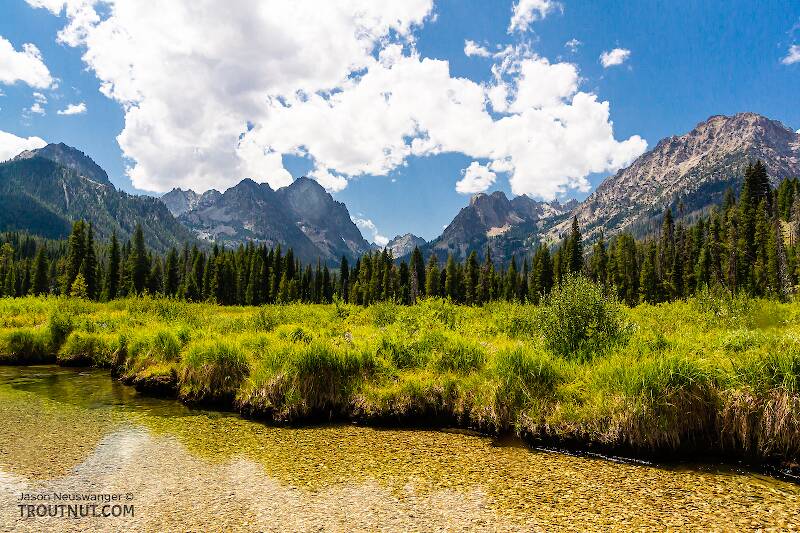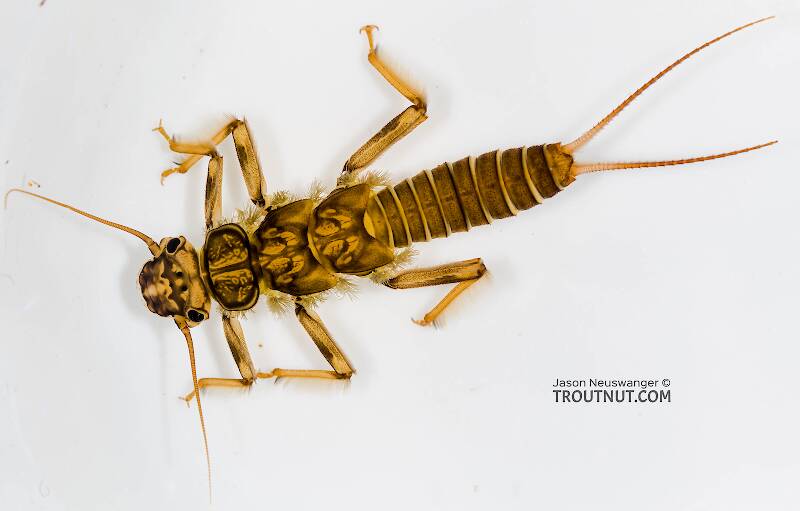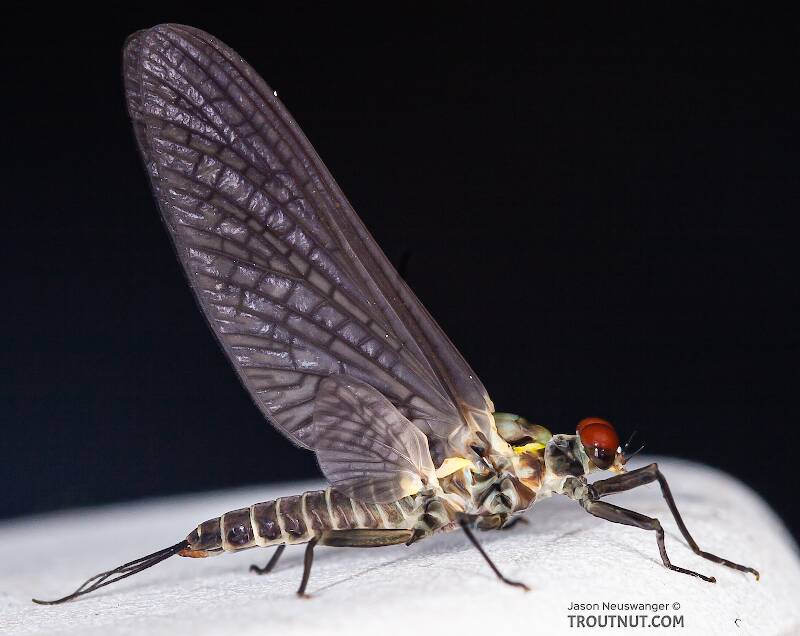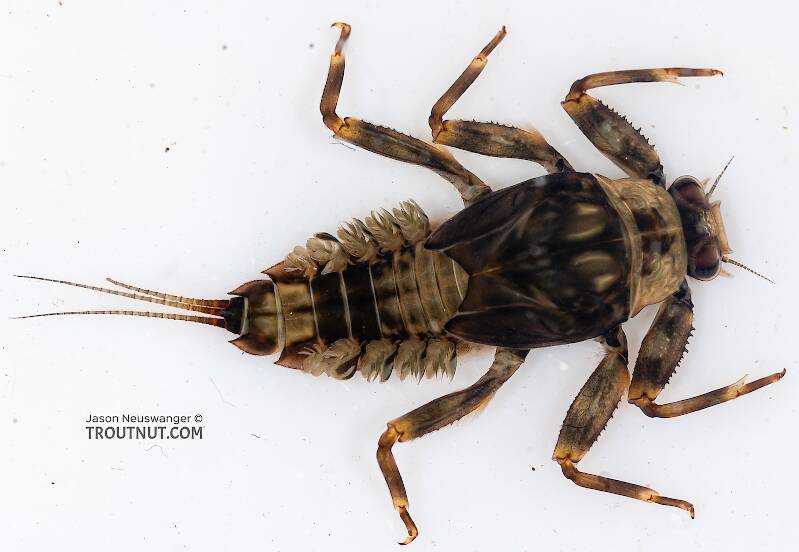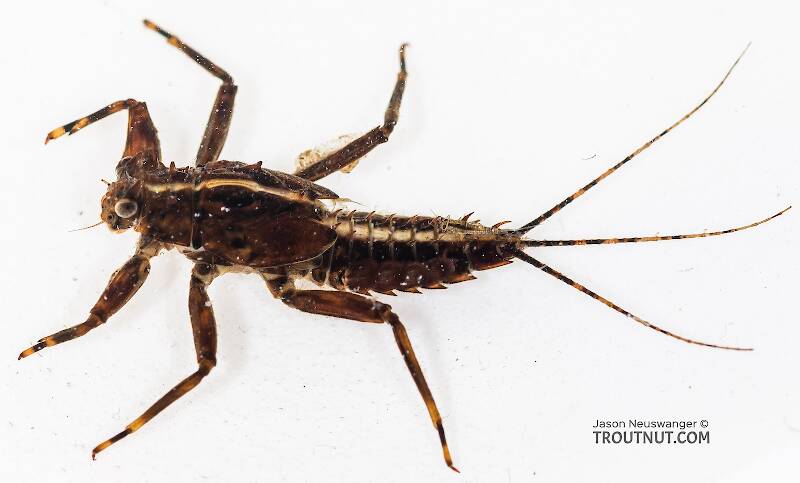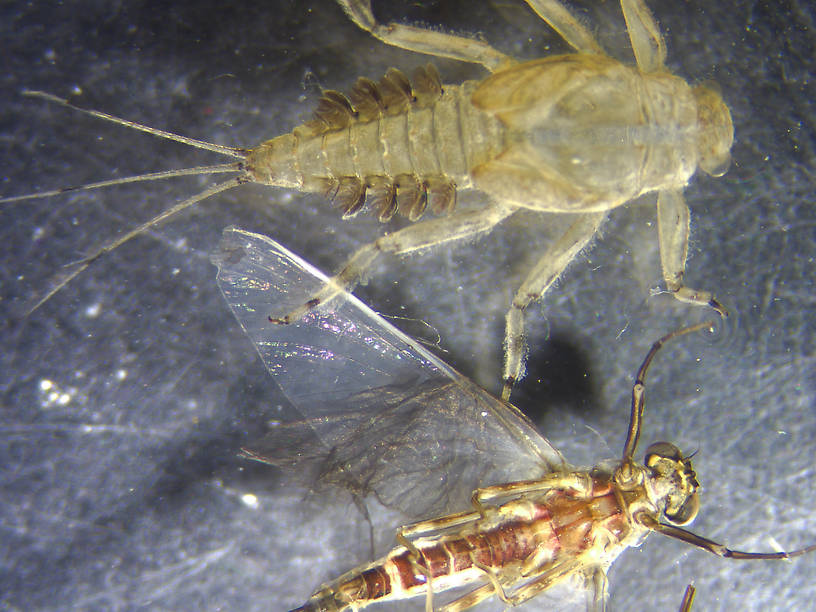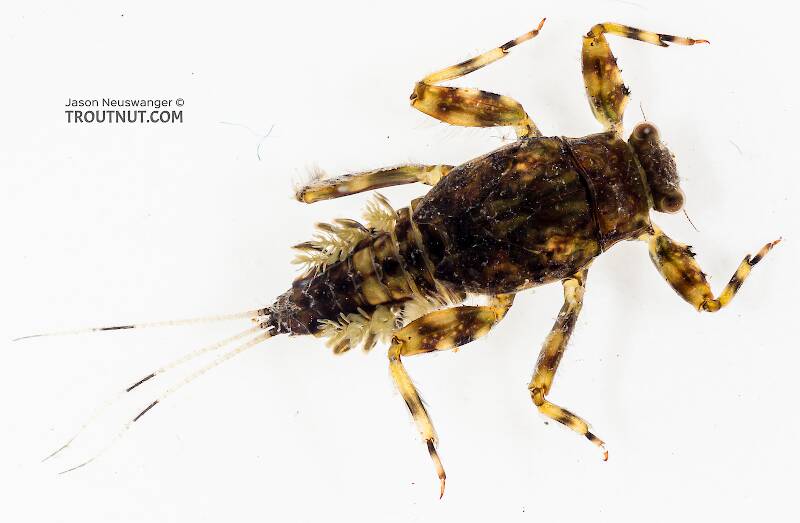
Blue-winged Olives
Baetis
Tiny Baetis mayflies are perhaps the most commonly encountered and imitated by anglers on all American trout streams due to their great abundance, widespread distribution, and trout-friendly emergence habits.
Featured on the forum

Troutnut is a project started in 2003 by salmonid ecologist Jason "Troutnut" Neuswanger to help anglers and
fly tyers unabashedly embrace the entomological side of the sport. Learn more about Troutnut or
support the project for an enhanced experience here.
Western Green Drakes
Like most common names,"Western Green Drake" can refer to more than one taxon. They're previewed below, along with 10 specimens. For more detail click through to the scientific names.
Mayfly Species Drunella doddsii
These are pretty much always called Western Green Drakes.
This species together with the Drunella grandis sub-species make up the Western Green Drake hatch. Besides being smaller, the adults are difficult to tell apart from it's larger siblings; but D. doddsi nymphs have a few peculiar traits that set them apart. D. doddsi looks much thicker in the thorax, has a flat frontal head margin and a unique oval disk-like ring of hairs on its ventral surface. However, There are very few differences between the habits of these two species, and they are almost always discussed together in fly fishing books, so for many of the characteristics of doddsii, refer to the Drunella grandis page.
See 10 more specimens...
Mayfly Species Drunella grandis
These are pretty much always called Western Green Drakes.
This species (or rather group of subspecies), together with Drunella doddsii, make up the famous Western Green Drake hatches. They are widespread throughout the vast Western region and can be abundant enough in many locations to provide world class angling.
It hasn't been all that many years since Western traditions and entomological "facts on the ground" began to influence the angler's lexicon heavily dominated by Eastern writers. Their initial reporting after visiting the region first popularized the phrase "Rocky Mountains answer to the popular Green Drakes of the East". This led to a false impression that lingers to this day. The reality is these giants of their family have abundant populations all over the West with no counterpart in the East, and the West does have abundant hatches of comparable Ephemeridae. The Western tradition of naming outsized Mayflies "Drakes" is the reason for what many consider a misnomer by giving it the same common name as the legendary Ephemerid of the East and surely contributed to confusion for anglers unconcerned with such subtleties.
It hasn't been all that many years since Western traditions and entomological "facts on the ground" began to influence the angler's lexicon heavily dominated by Eastern writers. Their initial reporting after visiting the region first popularized the phrase "Rocky Mountains answer to the popular Green Drakes of the East". This led to a false impression that lingers to this day. The reality is these giants of their family have abundant populations all over the West with no counterpart in the East, and the West does have abundant hatches of comparable Ephemeridae. The Western tradition of naming outsized Mayflies "Drakes" is the reason for what many consider a misnomer by giving it the same common name as the legendary Ephemerid of the East and surely contributed to confusion for anglers unconcerned with such subtleties.
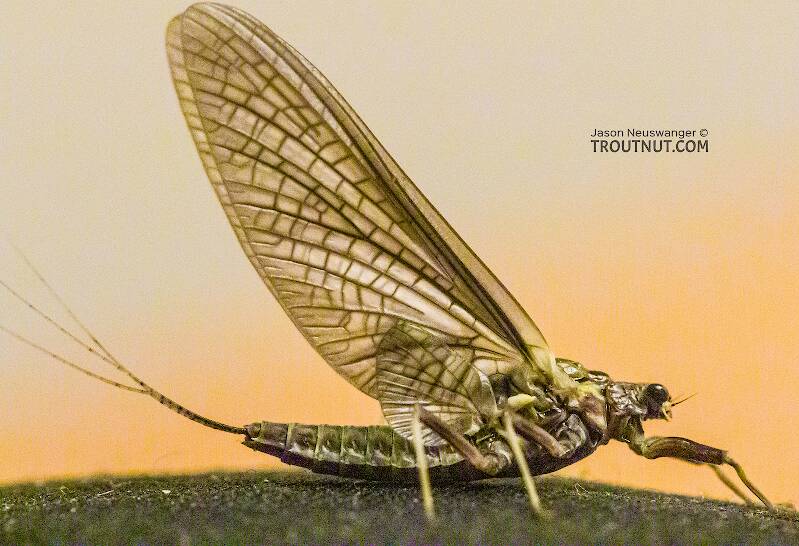
I collected this specimen while away from all my good photography equipment except the camera and one of my macro lenses, so I made do. The lighting is from lamps in a hotel room, so it was hard to edit for really true colors, but I tried to get as close as possible. The body was 13 mm long, wing 19 mm long.
See 10 more specimens...
Mayfly Species Drunella coloradensis
These are very rarely called Western Green Drakes.
This species is very similar to Drunella flavilinea. In areas where their ranges overlap, they can sometimes be found in the same streams. They are similar enough that anglers sometimes refer to either or both species as "Flavs." Allen and Edmunds (1962) say that Drunella coloradensis tends to favor colder water than Drunella flavilinea and that it may emerge as much as a month later.
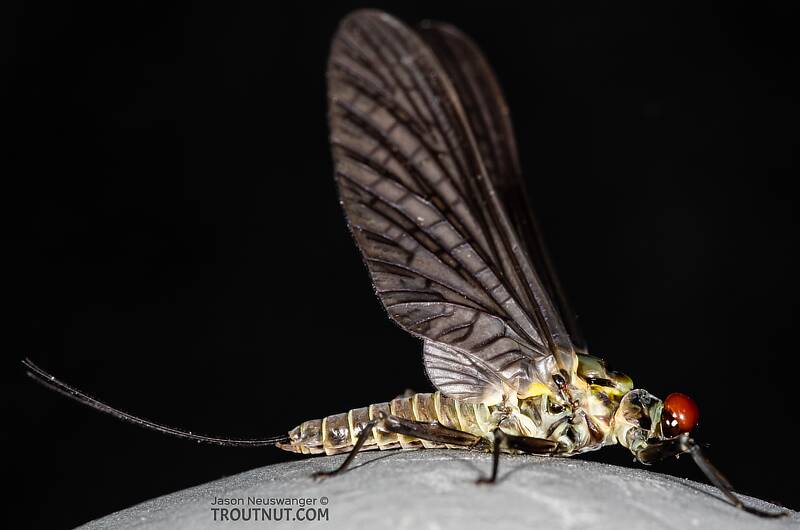
The positive species ID on this dun comes from both the spinner that it (or possibly one other dun just like it) molted into and the overwhelming abundance of nymphs of this species in my kicknet samples from the same site.
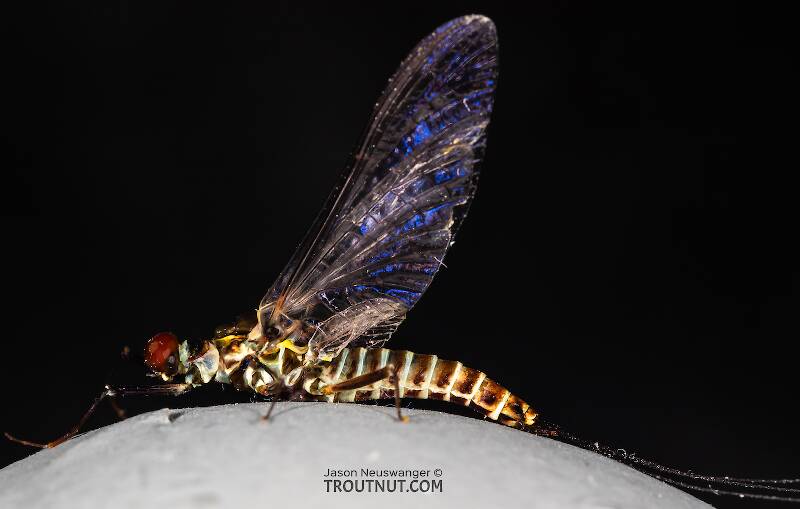
This spinner molted from this dun, or possibly one other dun I had in the same container that looked just like it.
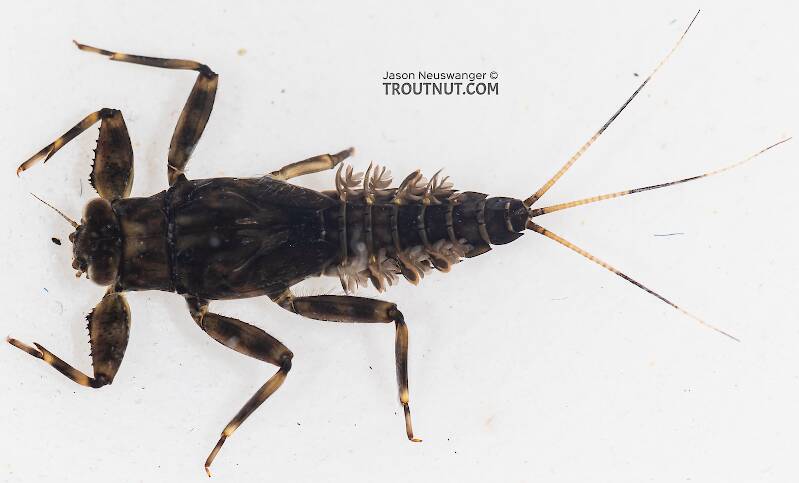
This one nicely illustrates the variation in coloration within an single Ephemerellid species in a single stream, when compared to its lighter, banded counterpart.
See 7 more specimens...
Mayfly Species Drunella flavilinea
These are very rarely called Western Green Drakes.
The Flavs pick up about a week after the closely related but larger Western Green Drakes (Drunella grandis and Drunella doddsii) finish hatching on most Western waters.
Their hatches may be complemented by simultaneous hatches of two less prolific species, Drunella coloradensis and Drunella spinifera.
Their hatches may be complemented by simultaneous hatches of two less prolific species, Drunella coloradensis and Drunella spinifera.
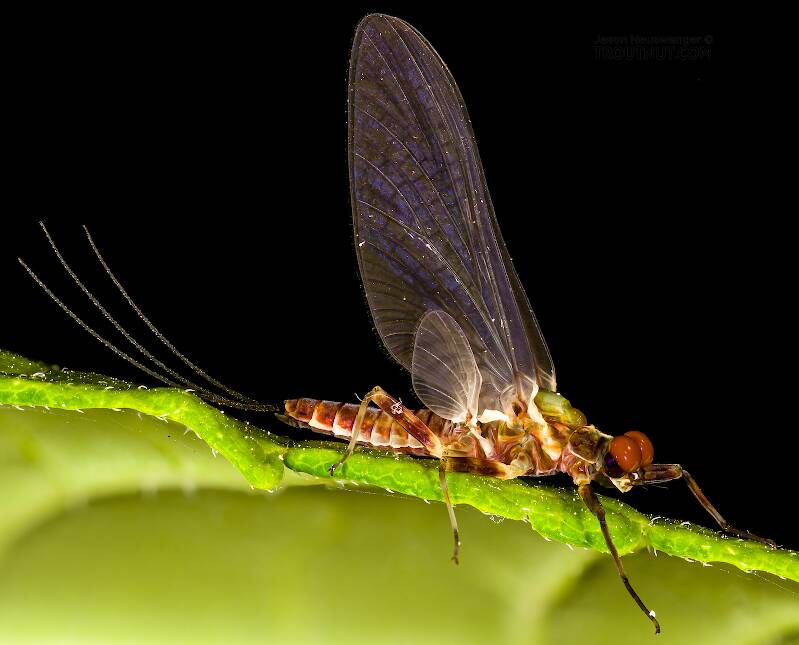
This dun is smaller than would normally be expected for Drunella flavilinea, but it seems to fit the physical description of that species fairly well. I wasn't sure from the dun pictures alone, so I was hoping it would molt into a spinner. It never made it out of the dun's shuck, but it did begin the process, which allowed me with great care to tease out the last couple abdominal segments of the spinner from the still tightly attached dun shuck, enabling a more confident ID based on the shape of the spinner's penes and sub-genital plate. I also collected a nymph of flavilinea in the same river on the same evening, as well as a shed exuvium that looked large enough to belong to an emerging dun.
The other possibility I considered for a while based on the dun was Drunella pelosa, which would be the right size, but the other characteristics don't fit.
The other possibility I considered for a while based on the dun was Drunella pelosa, which would be the right size, but the other characteristics don't fit.
See 2 more specimens...

